Veterans Airlift flies 10,000th passenger
By Julie Summers Walker
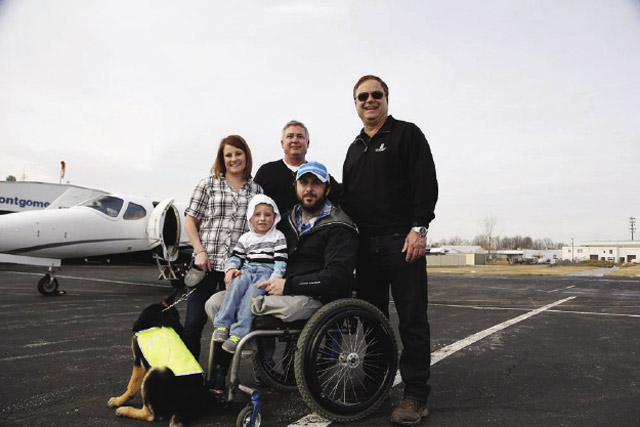
Sgt. Jesse Murphree holds his son, Brody; his wife, Ashlee has Atticus on his leash. Co-pilot Mark Hogan (center) and pilot Mike Bell stand behind.
The numbers tell the magnitude of this story. Several days after his sixty-second surgery for life-threatening wounds suffered in an explosion in Afghanistan, Sgt. Jesse Murphree became the 10,000th passenger flown by volunteer pilots of the Veteran’s Airlift Command. It was volunteer pilot Mike Bell’s fourteenth mission.
“10,000 is a really big deal,” said Murphree, a soft-spoken young man who lost both his legs and partial use of his arm during a patrol in the Korengal Valley, also known as the Valley of Death. On December 27, 2007, serving as a gunner on an up-armored Humvee, Murphree’s vehicle was blown apart by a Russian anti-tank mine. He technically died six times during early surgeries.
Your chance to experience business aviation
‘AOPA Pilot’ and Pilatus kick off ‘BizAv and You’ contest
By Thomas B. Haines
 Some AOPA members accuse us of having all the fun when it comes to sampling a variety of airplanes. Well, here’s your chance to get in on the action. AOPA is working with Pilatus Aircraft to give a pilot a chance to fly a PC–12 NG on missions that showcase the capabilities of business aircraft. Bring along up to three friends, clients, or colleagues. We’ll document the experience in words, photos, and video and share it with AOPA members in AOPA Pilot and AOPA ePilot, on AOPA.org, and AOPA Live This Week.
Some AOPA members accuse us of having all the fun when it comes to sampling a variety of airplanes. Well, here’s your chance to get in on the action. AOPA is working with Pilatus Aircraft to give a pilot a chance to fly a PC–12 NG on missions that showcase the capabilities of business aircraft. Bring along up to three friends, clients, or colleagues. We’ll document the experience in words, photos, and video and share it with AOPA members in AOPA Pilot and AOPA ePilot, on AOPA.org, and AOPA Live This Week.
The PC–12 is an amazingly versatile airplane, equally at home in town or country. Stuff a bunch of equipment to show prospects in through the commodious cargo door in the back or usher clients into first-class leather seats for a comfortable, pressurized trip back to your factory to seal the deal. No matter the runway surface, the PC–12 climbs away carrying almost two tons of fuel and stuff, headed for the flight levels where it will cruise at more than 270 knots. With full fuel, the turboprop can range some 1,500 nm while carrying 1,000 pounds of people and gear.
The AOPA Pilot “BizAv and You Contest Powered by Pilatus” began March 1 and ends June 30. The contest is open to people who own or work for a company that would benefit from the use of a business aircraft such as the PC–12 NG. To enter, send a 300-word or less description of how your company would take advantage of a turbine business aircraft if you had access to it. The entries will be judged by the editorial staff at AOPA. Special consideration will be given to those who outline missions that take advantage of the PC–12 NG’s unique capabilities of operating off of a variety of runway surfaces, and into and out of remote areas with unusual gear.
Pilatus Aircraft will supply a PC–12 NG for up to eight hours of mission flying on up to four consecutive days—all within the contiguous 48 U.S. states. Two Pilatus corporate pilots will be on the trip. However, if you’re a pilot and the Pilatus pilots approve, you will get a chance to fly some of the legs. You may bring along up to three others and AOPA will bring along a writer and a photographer/videographer. The PC–12 NG seats up to 11.
The winner will be responsible for getting to the starting point of the mission and return to their home base; although the mission can be a round-robin trip. AOPA will provide food and accommodations for the winners during the trip.
Here’s more of that legalese: If all of the eight flight hours are used, the prize has a taxable value of about $13,000. We’ll throw in $4,000 in cash to help cover the taxes, raising the taxable value to $17,000. But the winner is responsible for paying any applicable taxes, whatever they may be.
Game? See the official rules. See you on the ramp.
Email [email protected]
Learn more about the PC-12 NG and its capabilities.
And email those 300-word descriptions of how you’d use such an airplane in a Word document to: [email protected] before 5 p.m. Eastern time June 30, 2015.
We plan to notify the winner by July 10, 2015. The trip must be completed by September 18, 2015, at a mutually agreed upon time and place with AOPA and Pilatus.
Cessna Latitude nears certification
Model could lead company’s jet sales
By Jim Moore
Cessna Aircraft is on track for certification in the second quarter following recent program milestones.
The Latitude was first announced in October 2011 and has logged 500 flights and 1,200 hours. It has a promised 2,700-nautical-mile range (increased 200 nm from previous estimates in part by larger fuel tanks). It will carry up to nine passengers, is claimed to reach 43,000 feet in 24 minutes, and can maintain a cabin altitude of 6,000 feet up to its maximum operating altitude of 45,000 feet.
The $16.2 million Latitude is important to Cessna’s fortunes. Like most manufacturers, the company has seen sales decline in recent years, and the Latitude and Longitude—also in development—are expected to help the Wichita firm reclaim lost market share. Analysts have said Bombardier’s recent woes will likely spell more sales for Cessna and its parent, Textron Aviation.
“Our product investments extend beyond the design and performance features of the aircraft with innovations in our manufacturing processes,” said Scott Ernest, president and CEO, in a news release. “The Citation Latitude team has redefined what customers should expect from a business aircraft in this segment, while also redefining the aircraft build process.”
Email [email protected]
Spreading the gospel of flight
AOPA reaching out with You Can Fly program
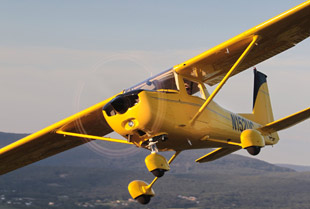 Sharing the passion you have for flight is the best way to introduce others to the joy of flying. AOPA is building a program that will launch aircraft and pilots into the skies to carry the message of its You Can Fly program, which it hopes will allow the association to share its love of flying, too—and hopefully motivate more people to enter or re-enter aviation. This program specifically supports AOPA’s flying clubs, flight training, and rusty pilots programs.
Sharing the passion you have for flight is the best way to introduce others to the joy of flying. AOPA is building a program that will launch aircraft and pilots into the skies to carry the message of its You Can Fly program, which it hopes will allow the association to share its love of flying, too—and hopefully motivate more people to enter or re-enter aviation. This program specifically supports AOPA’s flying clubs, flight training, and rusty pilots programs.
Bright yellow Cessna 152s, restored by Aviat Aircraft of Afton, Wyoming, will be piloted by AOPA Ambassadors who will help flying clubs and flight schools on a grassroots level strengthen and grow. AOPA through this program will ensure clubs and schools have the resources they need to be successful in keeping pilots engaged in the aviation community and help build new pilots. The Ambassadors will help connect schools and clubs with one another to share best practices, deliver resources to help with starting and running clubs and flight schools, connect with the industry, and encourage ways to make flying more affordable.
The first AOPA Ambassadors in the field are: Jamie Beckett, Florida; Kay Sundaram, Southern California; Sean Collins, Northeast; and Dave Ulane, Northwest.
Want a bright yellow 152 to visit your flying club or flight school? Contact AOPA Ambassadors (http://youcanfly.aopa.org).
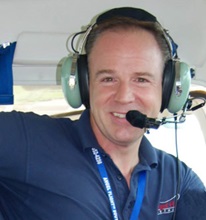
Honorees announced
Endeavor Awards choose 2015 recipients
By Julie Summers Walker
The second annual Endeavor Awards have announced the recipients of three $15,000 awards to help continue their work in public benefit flying. John Billings of Angel Flight Mid-Atlantic, Rick Durden of LightHawk, and Steve Purello of Angel Flight Southwest will be honored May 30 at the Endeavor Awards Gala, which will be held in the Endeavor Pavillion at the California Science Center in Los Angeles.
The Endeavor Awards celebrate and honor volunteer pilots and provide support to the organizations that coordinate their gifts of flight to serve those in need. Every year thousands of donated flights save lives, provide access to medical care, transport veterans, rescue animals, map environmental data, aid in disaster relief, and contribute to the public good in communities nationwide.
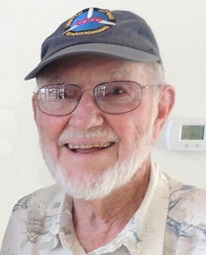
Compassionate volunteer pilots donate all expenses for their general aviation aircraft, and commercial airlines provide free seats, as a public and humanitarian service in communities across the country. They transport adults and
children who need assistance in reaching medical care and other services. They transport wounded warriors, give honor flights to veterans, and reunite military families. They rescue and relocate animals to new families or better habitats. They provide environmental oversight and data collection. They assist in disaster relief and international airlifts for sudden disasters or long-term assistance.
The Endeavor Awards were established by Angel Flight West, a volunteer pilot organization arranging 3,500 flights each year in the 13 western states. AFW recognized the need for a national platform to increase awareness and support for the use of aviation by individual pilots and their commercial airline partners to provide free transportation for humanitarian purposes.
The number of charitable flights is estimated to be 25,000 a year. The Endeavor Awards are presented as the centerpiece of a campaign to raise general awareness of public benefit aviation and to spur the collection of data to quantify the importance of charitable flights so generously donated by pilots and airlines.
 Email [email protected]
Email [email protected]
The Endeavor Awards are dedicated to:
• Increasing awareness of the contributions of aviation to the public good
• Encouraging more pilots and aircraft owners to become engaged in public benefit aviation
• Increasing support for all volunteer pilot organizations that provide the administration necessary to match donated flights with those in need of free transportation to access humanitarian services
Honorees are Steve Purello (top), John Billings (center), and Rick Durden (above)
Warbird flyover planned in Washington, D.C. , May 8
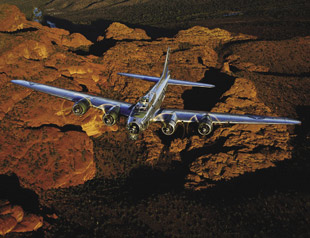 The 70th anniversary of victory in Europe during World War II will be celebrated with a massive warbird flyover above the Washington, D.C., World War II memorial May 8 at 12:10 p.m. The 40-minute event is part of a three-day Arsenal of Democracy celebration.
The 70th anniversary of victory in Europe during World War II will be celebrated with a massive warbird flyover above the Washington, D.C., World War II memorial May 8 at 12:10 p.m. The 40-minute event is part of a three-day Arsenal of Democracy celebration.
The Boeing B–29 Superfortress FIFI, operated by the Commemorative Air Force, is scheduled to be among the historically sequenced formations made up of training aircraft, fighters, and bombers used in Europe and the Pacific. Details are on the event website.
Organizations such as Texas Flying Legends, Fighter Factory, and Fagen Fighters have committed multiple aircraft, as have a number of individual owners. Aircraft expected to participate in the formations are the Curtiss P–40 Warhawk, Bell P–39 Aerocobra, Lockheed P–38 Lightning, North American P–51 Mustang, Republic P–47 Thunderbolt, Chance Vought (also built by Goodyear) FG–1D Corsair, North American B–25 Mitchell, and Boeing B–17 Flying Fortress.
Air & Space magazine plans to print 1940s-era plane-spotter cards in its May issue so spectators and youngsters can identify the aircraft.
“Arsenal of democracy” is a phrase coined by President Franklin D. Roosevelt in a December 1940 radio address in which he promised help to allies while acknowledging public sentiment against entering the war. —AKM
Helicopter News
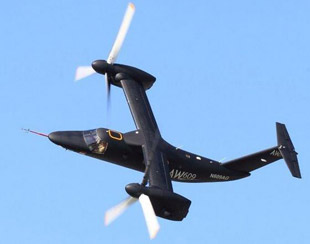 AugustaWestland will build the AW609 Tiltrotor at its Philadelphia facility. Bell sold its stake in the program several years ago. Promised for certification in 2017, the rotorcraft will travel 750 nautical miles at a claimed 275 knots. Airbus Helicopters (formerly Eurocopter) officials say they will have the 160-knot H160 mid-size helicopter in service in 2018. The 12-passenger twin Turbomeca-powered helicopter features Blue Edge main rotor blades with swept tips to reduce noise levels. The tail section carries the largest Fenestron shrouded tail rotor ever produced. Bell Helicopter now offers the 407GXP featuring an additional 50 pounds of payload, a new M250 Rolls-Royce engine, and new avionics. It was launched with an order from Air Methods Corp. for 200 407GXPs configured for air ambulance missions. The 407GXP is derived from the Bell 407GX platform. It is claimed to have better fuel efficiency and hot-temperature, high-altitude performance. New Zealand’s Composite Helicopters will move from carbon fiber kit helicopters to fully certified aircraft. It will offer a KC630 five-seat helicopter powered by a Rolls-Royce 300 turboshaft engine; a mid-level KC640 with a Rolls-Royce 250 C20B engine; and a higher-powered, six-seat KC650 with a Honeywell LTS101 engine. Certification of the KC630 is promised for late 2017, while the KC650 and KC640 are set for 2018. Guimbal of France has a few customers in the United States for its recently certified Cabri G2 trainer. The first $400,000 Cabri G2 went to Precision Helicopters in Newberg, Oregon. The helicopter has been flying for five years, and is currently operated in 22 countries.
AugustaWestland will build the AW609 Tiltrotor at its Philadelphia facility. Bell sold its stake in the program several years ago. Promised for certification in 2017, the rotorcraft will travel 750 nautical miles at a claimed 275 knots. Airbus Helicopters (formerly Eurocopter) officials say they will have the 160-knot H160 mid-size helicopter in service in 2018. The 12-passenger twin Turbomeca-powered helicopter features Blue Edge main rotor blades with swept tips to reduce noise levels. The tail section carries the largest Fenestron shrouded tail rotor ever produced. Bell Helicopter now offers the 407GXP featuring an additional 50 pounds of payload, a new M250 Rolls-Royce engine, and new avionics. It was launched with an order from Air Methods Corp. for 200 407GXPs configured for air ambulance missions. The 407GXP is derived from the Bell 407GX platform. It is claimed to have better fuel efficiency and hot-temperature, high-altitude performance. New Zealand’s Composite Helicopters will move from carbon fiber kit helicopters to fully certified aircraft. It will offer a KC630 five-seat helicopter powered by a Rolls-Royce 300 turboshaft engine; a mid-level KC640 with a Rolls-Royce 250 C20B engine; and a higher-powered, six-seat KC650 with a Honeywell LTS101 engine. Certification of the KC630 is promised for late 2017, while the KC650 and KC640 are set for 2018. Guimbal of France has a few customers in the United States for its recently certified Cabri G2 trainer. The first $400,000 Cabri G2 went to Precision Helicopters in Newberg, Oregon. The helicopter has been flying for five years, and is currently operated in 22 countries.
—AKM
Enstrom helicopter inspections mandated
The FAA issued an emergency airworthiness directive in February on certain models of Enstrom helicopters after an instructor and his student nearing her private helicopter checkride died January 26 at Erie Municipal Airport, north of Denver. The FAA said a cracked spindle resulted in separation of the main rotor blade.
The airworthiness directive came after Enstrom issued a nearly identical service bulletin on February 11. The helicopter was reported by a witness to the Daily Camera newspaper to be making a steep approach. The Enstrom 280FX was owned by New Course Aviation, operated by Erie-based Mountain One Helicopters.
The directive was issued to owners and operators of various Enstrom Helicopter Corp. model F–28s, F280s, plus the Model 480 with serial numbers 5001 through 5006, with a main rotor spindle part number 28-1482-11 or 28-14282-13. Cracked spindles must be replaced prior to flight. (For more on Enstrom, see “Made in Michigan,” AOPA Pilot, March 2015.)
A witness reported hearing a loud pop as the helicopter began to descend. Killed were instructor Alex Viola, 23, of Arkansas City, Kansas, and helicopter student Amy Wood, 25, who stated on a Web site she was planning a career as a helicopter pilot.
Meanwhile, an emergency landing in New Zealand prompted the FAA to issue a special airworthiness information bulletin (SAIB) pertaining to Robinson R44 and R44 II model helicopters with a particular main rotor installed. The SAIB applies to helicopters with the main rotor part number C016-7, and the FAA recommends a daily preflight check for signs of cracking or fatigue on the trailing edge of the rotor.
The pilot of an R44 II flying in New Zealand made a difficult but successful emergency landing after an in-flight failure resulted in severe main rotor vibration. New Zealand aeronautical authorities issued a similar bulletin in January. —AKM
Email [email protected]
Air Force role model finds success
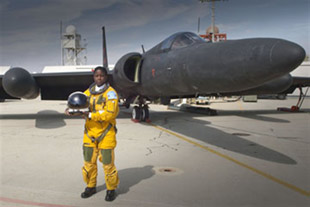 The only black Lockheed U–2 pilot in the history of the aircraft, stretching back to 1955, has been placed on the waiting list for promotion to full bird colonel. Lt. Col. Merryl Tengesdal is one of eight female pilots to ever fly the U–2.
The only black Lockheed U–2 pilot in the history of the aircraft, stretching back to 1955, has been placed on the waiting list for promotion to full bird colonel. Lt. Col. Merryl Tengesdal is one of eight female pilots to ever fly the U–2.
The Bronx, New York, native is still flying the aircraft in the 9th Reconnaissance Wing at Beale Air Force Base near Marysville, California, and is that unit’s inspector general. The promotion could come in the next few months.
“I have seen the curvature of the earth,” Tengesdal said. “I have seen sights most people will never see. Flying at more than 70,000 feet is really beautiful and peaceful. I enjoy the quiet, hearing myself breathing, and the hum of the engine. I never take it for granted.”
August 1, 2015, will mark the sixtieth anniversary of the U–2, making it one of the few aircraft to operate in the U.S. Air Force for more than 50 years.
The U–2 first flew in 1955, in the same year the Montgomery, Alabama, bus boycott and the Civil Rights Movement began, setting the stage for desegregation.
“The Air Force has always been on the forefront of breaking aviation and racial barriers,” Tengesdal said. “I am extremely proud of being the first black female U–2 pilot in history.” —AKM
Continental alternative fuel engine certified
Continental Motors announced FAA certification of its IO-360-AF six-cylinder engine that can be operated with 100LL avgas or unleaded 91UL fuel.
Germany’s Flight Design GmbH will take delivery of the first certified engine in the second quarter of 2015, Continental said, describing the powerplant—the lightest of its six-cylinder aircraft engines—as “a perfect solution for the new Flight Design C4 carbon, four-seat aircraft.”
The IO-360-AF family of engines provides a maximum output of 195 horsepower at 2,800 rpm. It will be derated to 180 horsepower and 2,550 rpm for the C4. The engine has a 2,200-hour time between overhauls.
The FAA certified the IO-360-AF (the AF stands for alternative fuels) engine in January. The engine should benefit aircraft operators in “certain markets where 100LL avgas is relatively expensive and with the expanding availability of 91UL,” Continental said. The reference is to overseas markets. —Dan Namowitz
Pulitzer Prize winner David McCullough has written a new book, The Wright Brothers, due out May 5. Past books include Truman, John Adams, and 1776.
F–86A under restoration
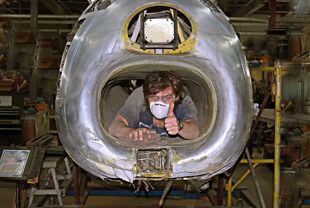 Last issue we reported that the North American F–86A Sabre that will fly at Oshkosh is the only one in the world. Not so, say officials of the Military Aviation Preservation Society (MAPS) Air Museum, located at the Akron-Canton Regional Airport at Akron, Ohio. They have a 1949 F–86A in restoration that came to them from the National Museum of the United States Air Force at Wright-Patterson Air Force Base near Dayton, Ohio. It will be completed in a few years and is for display only.
Last issue we reported that the North American F–86A Sabre that will fly at Oshkosh is the only one in the world. Not so, say officials of the Military Aviation Preservation Society (MAPS) Air Museum, located at the Akron-Canton Regional Airport at Akron, Ohio. They have a 1949 F–86A in restoration that came to them from the National Museum of the United States Air Force at Wright-Patterson Air Force Base near Dayton, Ohio. It will be completed in a few years and is for display only.
The aircraft won the Thompson Trophy at the National Air Races in September 1949 in Cleveland and was flown by Air Force Capt. Bruce Cunningham. During a final high-G turn the left horizontal stabilizer on the tail was damaged and the elevator was torn off. —Alton K. Marsh
Photo: Ken Ramsay
This month in aviation
MAY 30, 1899. Wilbur Wright affirms his belief that human flight is possible in a letter to the Smithsonian Institution.
MAY 22, 1906. Patent number 821,393 is issued to the Wright brothers for their “Flying Machine.”
MAY 25, 1910. Orville and Wilbur Wright make a short flight together at Huffman Field in Ohio—it is the only time they fly together.
MAY 30, 1912. Wilbur Wright dies at age 45.
MAY 3, 1919. First municipal airport in the United States is dedicated in Atlantic City, New Jersey.
MAY 9, 1926. Cmdr. Richard E. Byrd and pilot Floyd Bennett complete first flight over the North Pole.
MAY 20-21, 1927. Charles Lindbergh flies the Spirit of St. Louis nonstop across the Atlantic.
MAY 20-21, 1932. Amelia Earhart is the first woman to fly solo across the Atlantic.
MAY 12, 1936. World’s largest high-speed wind tunnel is put in operation at Langley Field, Virginia.
MAY 6, 1937. The Hindenburg explodes during landing at Lakehurst, New Jersey.
MAY 8, 1945. The war in Europe ends with the collapse of Germany.
MAY 5, 1961. First American manned space flight—Freedom 7 with Alan Shepard.
MAY 4, 1964. Jacqueline Cochran sets the world speed record for women in a Lockheed F-104G Starfighter.
MAY 2-16, 1992. First flight of the Space Shuttle Endeavour.
MAY 16, 2011. Final flight of the Space Shuttle Endeavour.
'This Month in Aviation' Sponsored by Breitling
“I wish people would recognize how much this helps us,” he said as he and his family prepared to board Bell’s Cessna Citation Mustang for their flight home to Florida. “What these guys are doing for us helps so much. Their hearts are so big, they do anything to help—they need to be recognized.”
Murphree’s wife, Ashlee, wrangling their 4-year-old son Brody; 6-month-old German Shepherd, Atticus; and the luggage and equipment needed to transport this little family and the stuff that keeps them going, said, “You can only imagine what it’s like getting us through an airport! It’s amazing how it helps us out.”
Bell and co-pilot Mark Hogan said it’s hard to keep a dry eye. “Meeting these kids, seeing what great attitudes they have, it tugs at the heart,” said Bell. “I’ve learned not to complain anymore.”
Bell’s Mustang left the Gaithersburg (Maryland) Air Park for the two-hour flight to Clearwater, Florida, simply to take Murphree and his family home. Murphree was operated on at Walter Reed Medical Center in Bethesda, Maryland. Bell hoped to take the family to dinner—if they were up to it—when they got home to Florida. Brody and Atticus, after all of the excitement, probably slept all the way home.
Long on compassion, short on red tape
Veterans Airlift Command Hero Flights provide free air transportation to post-9/11 combat-wounded veterans and their families for medical and other compassionate purposes through a national network of volunteer aircraft owners and pilots.
Video Extra: See an interview with Sergeant Murphree and pilot Mike Bell.


